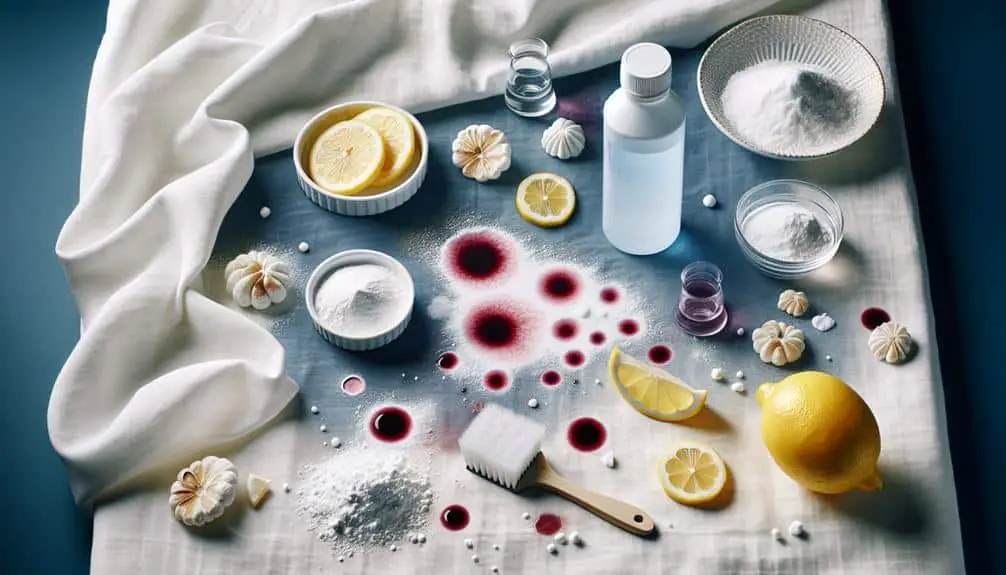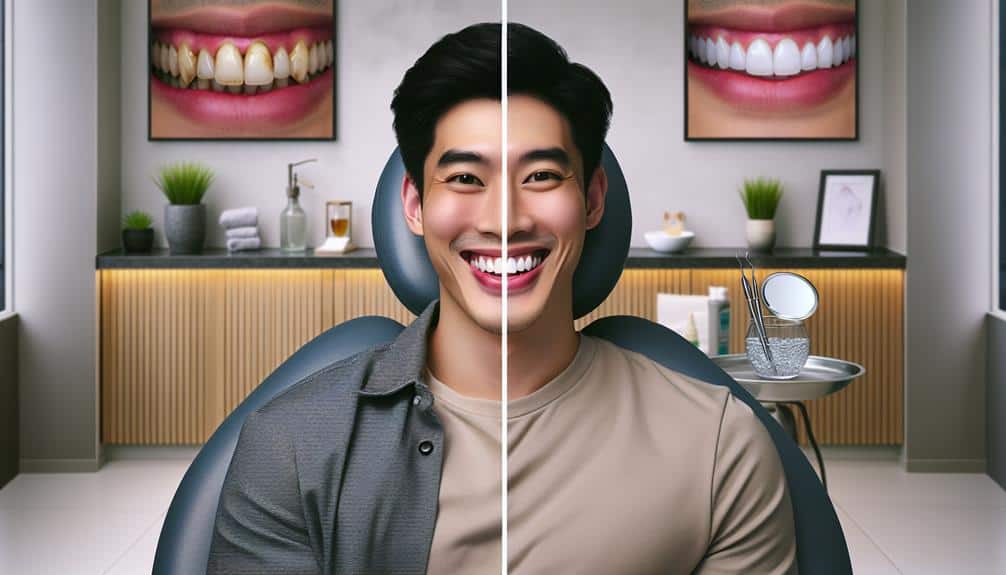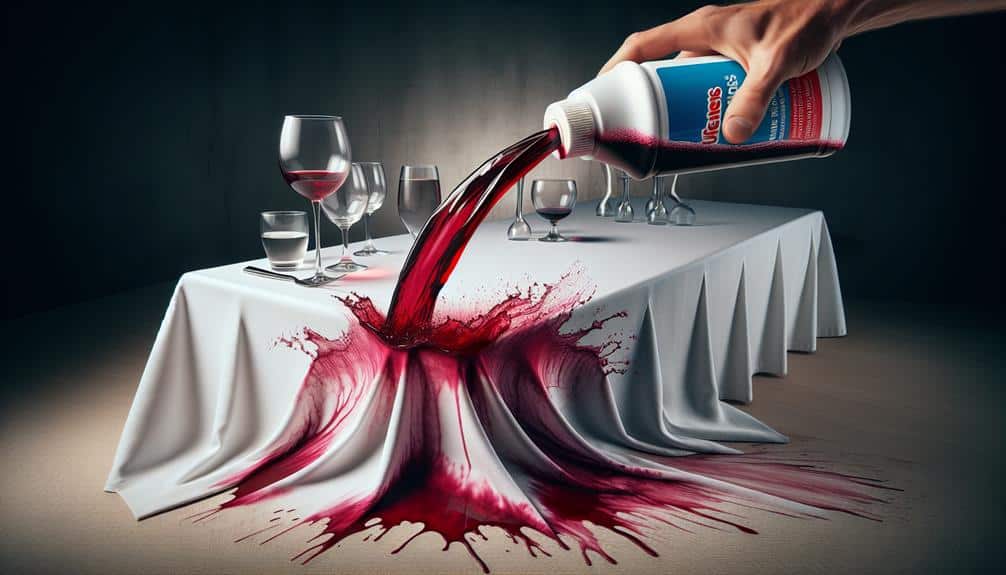When dealing with stubborn wine stains, consider these top whitening solutions: Start with Hydrogen Peroxide Treatment to break down pigments effectively. Try making a Baking Soda Paste for its gentle abrasive action. Opt for Activated Charcoal Application for its exceptional stain-lifting properties. Remember to patch test before application and follow fabric care instructions. For more insights on these powerful stain-removing methods, explore how each solution works best for different types of stains.
Key Points
- Hydrogen peroxide treatment effectively whitens and removes stubborn wine stains.
- Baking soda paste acts as a potent solution with mild abrasiveness for tough stains.
- Activated charcoal application offers a natural and eco-friendly option for effective stain removal.
- Consider the fabric type and perform a patch test before applying any whitening solution.
- Follow specific instructions for each solution, such as blotting and rinsing, to achieve optimal results.
Hydrogen Peroxide Treatment
To effectively treat wine stains, consider using hydrogen peroxide as a powerful whitening solution. Hydrogen peroxide is an excellent oxidizing agent that can break down the pigments in wine stains effectively. When using hydrogen peroxide on fabric, it's important to perform a patch test in an inconspicuous area to make sure it doesn't cause any damage or discoloration.
For treating wine stains with hydrogen peroxide, you should start by gently blotting the excess wine with a clean cloth to absorb as much liquid as possible. Then, apply a small amount of hydrogen peroxide to the stain using a dropper or a clean cloth. Allow the hydrogen peroxide to sit on the stain for a few minutes to penetrate and break down the pigments. Afterward, gently blot the area with a clean cloth to lift the stain.
Utilizing a brushing technique can help work the hydrogen peroxide into the fibers, aiding in the stain removal process. Remember to always follow the fabric care label instructions and wash the treated garment promptly after removing the wine stain.
Baking Soda Paste
Consider creating a baking soda paste as a potent solution for tackling wine stains effectively. Baking soda, or sodium bicarbonate, has numerous benefits when it comes to stain removal. Its mild abrasive nature helps lift stains without damaging the affected surface. To create a baking soda paste, mix baking soda with a small amount of water to form a thick consistency.
When applying the paste to a wine stain, make sure the affected area is dampened first. Gently rub the baking soda paste onto the stain using a soft cloth or brush in a circular motion. Allow the paste to sit on the stain for about 30 minutes before rinsing it off with warm water. Repeat the process if necessary until the wine stain is no longer visible.
This DIY application technique is simple yet effective, making it a popular choice for treating stubborn wine stains. Baking soda's natural properties make it a safe and efficient option for whitening solutions, providing a practical way to restore surfaces affected by wine spills.
Activated Charcoal Application
Activated charcoal offers a powerful solution for effectively removing wine stains. This natural remedy has been praised for its ability to draw out impurities, making it a popular choice for tackling stubborn discoloration. When it comes to wine stains, activated charcoal can work wonders. Here are some key points to take into account when using activated charcoal for stain removal:
- Charcoal Powder Benefits: Activated charcoal is highly absorbent, which helps it lift stains from surfaces effectively.
- DIY Charcoal Masks: You can create a paste using activated charcoal powder and water to make a DIY stain-removing mask. Apply it to the affected area and let it sit for a few minutes before rinsing.
- Gentle yet Effective: Activated charcoal is gentle on most surfaces, making it a versatile and safe option for stain removal.
- Natural and Eco-Friendly: Unlike harsh chemical cleaners, activated charcoal is a natural and eco-friendly solution for combating wine stains.
Frequently Asked Questions
Can These Whitening Solutions Be Used on Delicate Fabrics Like Silk or Wool?
When caring for delicate fabrics like silk or wool, it's crucial to select stain removal options that cater to their needs. Make sure silk treatment is gentle yet effective, and prioritize wool protection to maintain their integrity.
Are There Any Potential Side Effects or Risks Associated With Using Hydrogen Peroxide for Wine Stain Removal?
When using hydrogen peroxide for wine stain removal, be aware of potential risks like skin irritation. Prioritize safety measures such as wearing gloves. Test on a small area first. Follow application techniques for effectiveness without compromising safety.
Can Baking Soda Paste Be Used on Colored Fabrics Without Causing Discoloration?
When it comes to caring for your colored fabrics, you'll be delighted to know that baking soda paste, along with color-safe alternatives, can be gentle on your garments, ensuring stain prevention without causing discoloration.
How Long Should Activated Charcoal Be Left on a Wine Stain Before Removing It?
For maximum effectiveness, leave activated charcoal on the wine stain overnight before removing. Vinegar can aid in stain removal. This method guarantees deep penetration and absorption, heightening the likelihood of successful stain removal.
Are There Any Alternative Methods for Removing Wine Stains That Do Not Involve These Whitening Solutions?
When it comes to tackling wine stains, you can explore natural remedies or DIY techniques before resorting to professional cleaning. Prevention is key; but if a stain persists, there's a world of options beyond whitening solutions.



